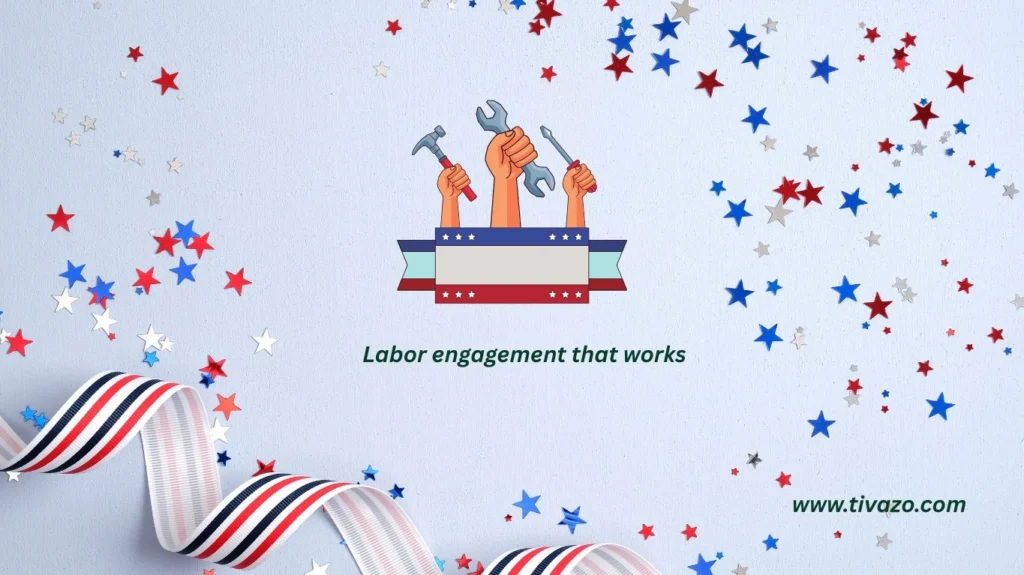Labor engagement isn’t a philosophy. It’s a business metric. You can measure it. You can improve it. You can lose it fast if you don’t pay attention. When labor engagement drops, output follows. Retention collapses. Teams fall apart.
Skip the buzzwords. Fix the work.
Define labor engagement
Labor engagement means how invested, committed, and mentally present a worker is in their job. It includes emotional effort, task ownership, and active participation in workplace objectives. Unlike compliance or presence, Workforce engagement reflects whether people care enough to think, contribute, and improve.
In today’s job market, labor engagement decides who stays, who quits, and who delivers results. With shifting work patterns, burnout spikes, and quiet quitting trends, Workforce engagement shows who’s checked in and who’s out. It’s no longer optional. It’s essential.
This article breaks down:
- What does labor engagement mean
- Why it matters more now than ever
- How to measure it without fluff
- How to fix it fast and stay consistent
Workforce engagement isn’t just an HR term. It’s a daily signal.
What is labor engagement?
Labor engagement is the level of attention, motivation, and energy a worker brings to their job. It reflects whether people are doing the bare minimum or pushing beyond. Labor engagement is evident in meetings, performance, and a willingness to improve broken systems.

It’s different from employee engagement. Employee engagement usually refers to full-time staff and includes culture surveys or company loyalty. Workforce engagement focuses on what people do with their time on task, regardless of role or contract type.
Historically, labor engagement has shifted. In the industrial age, it meant showing up on time. In knowledge work, it now means solving problems, collaborating, and owning deliverables. The definition keeps changing. The core idea doesn’t: labor engagement is about effort that matters.
Why Labor Engagement Matters in 2025
Since the pandemic, how people work has changed. Offices became optional. Screens replaced handshakes. Autonomy became standard. That shift also changed labor engagement. Managers can no longer see who’s working. They need new ways to tell who’s present, not just logged in.
In 2025, hybrid and remote work will be the norm. But engagement isn’t. Teams now face more distractions, more tools, and less personal connection. That’s where workforce engagement makes the difference. It’s how teams stay productive even when they’re miles apart.
The payoff is clear. High labor engagement means better work. Faster delivery. Lower churn. Stronger morale. And fewer mistakes. Data confirms it across every industry. Labor engagement keeps teams stable while everything else changes.
Key metrics to measure labor engagement
You can’t improve workforce engagement without measuring it. Start with behavior. Track how people respond, contribute, and follow through. Skip the fluff. Focus on real signals.
Use anonymous surveys. Check sentiment. Ask real questions. Use feedback loops that trigger action. Combine that with performance indicators like task completion, meeting participation, and quality reviews.
Digital tools help. Use apps like Clockify or Tivazo to track engagement over time. Measure consistency, not just presence. HR analytics platforms can show KPIs like absenteeism, turnover, and productivity drops.
Labor engagement is visible in numbers. You just have to look at the right ones.
Labor engagement that works
Labor engagement isn’t a philosophy. It’s a business metric. You can measure it. You can improve it. You can lose it fast if you don’t pay attention. When labor engagement drops, output follows. Retention collapses. Teams fall apart.
Skip the buzzwords. Fix the work.
Define labor engagement
Labor engagement means how invested, committed, and mentally present a worker is in their job. It includes emotional effort, task ownership, and active participation in workplace objectives. Unlike compliance or presence, labor engagement reflects whether people care enough to think, contribute, and improve.
In today’s job market, workforce engagement decides who stays, who quits, and who delivers results. With shifting work patterns, burnout spikes, and quiet quitting trends, labor engagement shows who’s checked in and who’s out. It’s no longer optional. It’s essential.
This article breaks down:

- What does labor engagement mean
- Why it matters more now than ever
- How to measure it without fluff
- How to fix it fast and stay consistent
Labor engagement isn’t just an HR term. It’s a daily signal.
Labor engagement is the level of attention, motivation, and energy a worker brings to their job. It reflects whether people are doing the bare minimum or pushing beyond. Labor engagement is evident in meetings, performance, and a willingness to improve broken systems.
It’s different from employee engagement. Employee engagement usually refers to full-time staff and includes culture surveys or company loyalty. Labor engagement focuses on what people do with their time on task, regardless of role or contract type.
Historically, labor engagement has shifted. In the industrial age, it meant showing up on time. In knowledge work, it now means solving problems, collaborating, and owning deliverables. The definition keeps changing. The core idea doesn’t: labor engagement is about effort that matters.
Why labor engagement matters in 2025
Since the pandemic, how people work has changed. Offices became optional. Screens replaced handshakes. Autonomy became standard. That shift also changed labor engagement. Managers can no longer see who’s working. They need new ways to tell who’s present, not just logged in.
In 2025, hybrid and remote work will be the norm. But engagement isn’t. Teams now face more distractions, more tools, and less personal connection. That’s where labor engagement makes the difference. It’s how teams stay productive even when they’re miles apart.
The payoff is clear. High labor engagement means better work. Faster delivery. Lower churn. Stronger morale. And fewer mistakes. Data confirms it across every industry. Labor engagement keeps teams stable while everything else changes.
Some of the main metrics to measure the engagement of labor
Without a measurement, you are not able to create better labor engagement. Begin with behavior. Monitor the responses, contributions, and follow-ups of people. Cut out the fluff. Indeed, speech is a real signal.
Adopt anonymous surveys. Check sentiment. Ask questions that are not chicken. Employ action inducing feedback loops. Add to that performance measures such as task completion, participation in meetings, and quality reviews.
Computer tools aid. Monitor your engagement over time by using such apps as Clockify or Tivazo. It is not enough to measure presence. HR analytics tools can display such indicators as absenteeism, attrition, and declines in productivity.
The use of labor is reflected in figures. You simply need to look at the appropriate ones.
The best action plans to enhance worker involvement
- Begin with the leadership. Human beings emulate leaders. When managers set objectives and deliver regular feedback, clearing blockers, labor engagement becomes high within no time. It falls under poor leadership.
- Next is communication. It is not only the announcements. Real communication. Twice-daily updates. Slack channels that are important. Teams that work well because they are aware of what to do and why they are doing it. In the absence of that, labor engagement perishes in silence.
- Recognition matters. There is no necessity for large prizes. A word in a group call is effective. The message that tells that somebody saw. People also like it when their efforts are seen, and this encourages labor participation.
- Engage in talent development. Show the individuals a motive to be on their toes. Availability of courses. Stretch projects. Cross-training. Engagement in labor increases because the job assists them in becoming better, rather than becoming busier.
- Practical timetables assist as well. Human beings live. Give them freedom to manage their time as much as possible. More labor participation will occur when employees are not viewed as time-punchers.
- High labor engagement is dominated by these five strategies, including clear leadership, good communication, real recognition, skill building, and autonomy. Omit one, and the whole thing goes to pot.
Part of technology in work engagement
Labor engagement can be supported with the assistance of technology in the case of friction elimination. Automated systems to get off menial tasks. Progressive dashboards. Goal-making systems. That is what helps.
Artificial intelligence promotes the tracking of trends in feedback and the identification of areas of risk. Tools such as Plaky provide tools that enable the coordinates of tasks, deadlines, and status to be organized in a single perspective. BambooHR heralds performance and alerts to disengagement trends in advance. Tivazo reveals time used information without micromanagement.
Have the technology to aid human judgment, not substitute it. The involvement of labor is enhanced when the equipment is easy to understand, efficient, and user-friendly.
General issues in labor participation
The killer number one is poor communication. Teams that are lost lose motivation. Ambiguous directions and having no clear objectives burn energy quickly.
The other one is burnout. Too many duties. No breaks. No acknowledgment. People get beaten up and get indifferent.

Misalignment forms the third. When a worker fails to comprehend the significance of a task, he will not take ownership of it. Contract involves labor arising out of purposefulness, clarity, and relevance. In the absence of these things, teams meander.
Labor engagement in use cases in the industry
- In the production process, workforce participation manifests itself in the quality and uniformity. The floor workers familiar with the output target detect defects quickly and are more concerned about achieving standards.
- In health, it influences patient outcomes. Feeling worthy and being appreciated by others, nurses and technicians remain more vigilant and understanding. Work participation at this place saves lives.
- In shopping, it influences the experience of customers. The engaged workers stock quicker, serve well, and sell more.
- In service industries, labor participation eliminates attrition. Troops that are highly engaged fix cases quicker and receive more positive reviews.
- No industry can succeed without labor involvement. In its absence, everything collapses in terms of performance. Future trends in labor engagement
- Predictive analytics will be applied in more companies to identify the early signs of disengagement. They will no longer wait until quarterly reviews to take the necessary action, but to nip the problems before they get out of hand.
- Individualised engagement strategies will increase. Managers will monitor each motivation that drives a team member and individualize communication and work.
- Employment will also have to get used to international teams. The differences in time zone, culture, and language will force companies to streamline processes and communication mailboxes.
conclusion
Engagement in labor has ceased to be an option. It forms outcomes, retention, and fortitude. Business organizations that measure and enhance the involvement of labor increase. All those who remain insensible to it are left behind.
Start small. Measure what is important. Show leadership with vision. The labor engagement is not a buzzword. It is what makes your best people remain.



